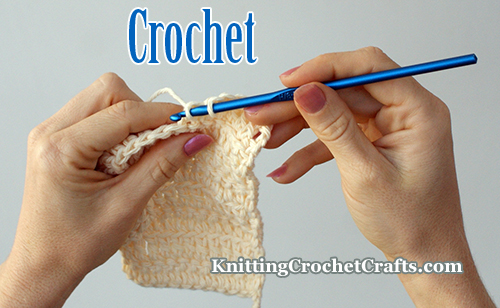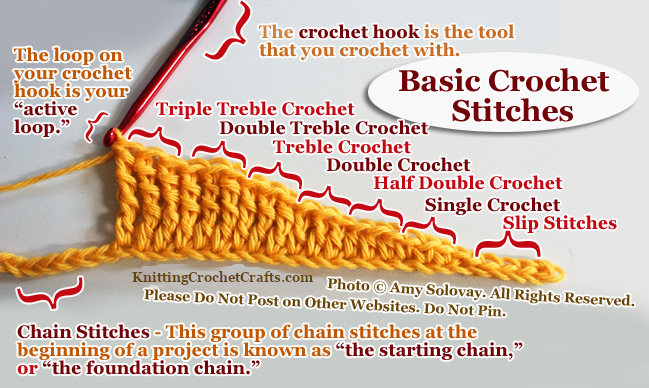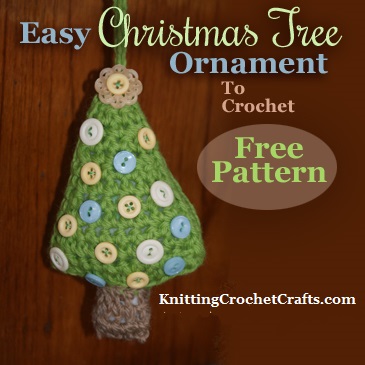What Is Crochet?

Crochet is a needlework technique performed using a crochet hook plus yarn, thread, fiber, wire, fabric strips, cut-up plastic bags or other similar material. People crochet for the purpose of creating useful items or art objects. Typically, people crochet projects such as blankets, hats, scarves, sweaters, baby projects, home decor items, clothing and accessories.
For some people, crochet is a hobby, or simply a pastime. For others, crochet is a means of earning extra income; for some, crochet is even a career. For many, crochet is a means of relaxing or relieving stress. Some people view crochet as being an art form; others would disagree, insisting that crochet is strictly a craft.
Crochet is low-tech, requiring only human hands, human creativity and a few simple materials. Crochet does not require electricity, batteries, or machines. It’s portable and versatile.
Crochet Projects
Types of Projects That Can Be Crocheted
Popular crochet projects include blankets, bedspreads, hats, scarves, sweaters, shawls, clothing, baby items, headbands, slippers, mittens, gloves, bags, purses, appliqués, rugs, placemats, dishcloths, washcloths, potholders, linens, gadget cozies, and stuffed toys.
Crafters often use crochet to create components for other sorts of projects — for example, knitters and quilters often use crocheted edgings to finish off knitted or quilted projects. Some home sewers enjoy using crocheted edgings on their sewing projects including placemats, napkins, pillowcases, and clothing.
There are many other possibilities for items that can be crocheted. Crochet probably isn’t the first method that comes to mind when you think of jewelry-making techniques, but it’s a viable means for creating exquisite jewelry pieces.
You can crochet a wide variety of different project types: baskets, organizers, pet beds and napkin rings are other possibilities.
For those who crochet as a means of artistic expression, crocheting results in an interesting range of different project types — not all of which are considered “useful items.”
Most artists agree that sculpture is an art form, and crochet can be used to create interesting sculptures.
Crochet can also be used to create pictorial, abstract or non-representational wall hangings.
There are people who use crochet as a way to create graffiti, also known as “yarn bombing.” Some freeform crocheters create spontaneous, artistic crocheted pieces with no particular purpose in mind.
Crochet Supplies: Materials You Need for Crocheting
Crochet can be achieved using a minimum of fiber and human fingers. However, the most efficient way to crochet involves using a hooked tool known as a crochet hook.
Yarn and crochet thread are the most popular materials used for crocheting. Imaginative crocheters also find creative ways to use other materials, including wire, raffia, string, twine, ribbon, roving, plastic shopping bags cut into strips, and fabric cut into strips and then wound into rag balls.
How to Crochet: The Process
There are several different way to begin crocheting. Traditionally, crocheters would often begin by making a slip knot and a series of chain stitches. The chain stitches could be joined to form a ring for crocheting in the round or left straight for crocheting in rows.
Alternatively, crocheters might begin their projects by crocheting directly into fabric, for example when putting the edging around a tablecloth or onto a sheet or pillowcase. They might also begin by embroidering a series of chains or blanket stitches, and then crocheting into the embroidered stitches.
Contemporary crocheters have other possible ways to begin, including the “magic ring” method and the foundation single crochet, foundation double crochet, etc.
After beginning the work, the crocheter then proceeds to work various crochet stitches or stitch patterns, then finishes the work — possibly by adding an edging or border around the outside. At the very end, the crocheter will typically end off and then weave in the ends. (S)he may also choose to block the work. Some projects need to be pieced together using either crochet or hand sewing techniques. Some benefit from the addition of various components such as zippers, buttons, beads, ribbons and appliqués.
Crochet Stitches

The basic crochet stitches are as follows:
- Crochet Chain
- Single Crochet
- Slip Stitch
- Half Double Crochet
- Double Crochet
- Treble Crochet
- Double Treble Crochet
- Triple Treble Crochet
Crochet Stitch Patterns
There are several ways crocheters refer to combinations of the basic crochet stitches. Sometimes, people just call them “crochet stitches,” without making any differentiation. Some crocheters, myself included, like to refer to them as “stitch patterns” or “crochet stitch patterns.” I prefer either of these designations, because they hint at something more complex than just the simpler basic stitches.
There are many well-known stitch patterns that have been popular for generations. A few of them include shells, picots, fans, lacets, popcorns, cluster stitches and pineapples. There are many others.
Crochet Techniques
One of the most fascinating things about crochet: you can make tiny variations in your hook placement, yarn placement or other details, and these variations result in different looks and different fabric characteristics.
Over the years, crocheters have developed a number of different techniques; each technique is an exploration of a certain aspect of what can be achieved with crochet. Each technique has its own benefits, and reasons you might want to choose it over others for a particular purpose.
These are just a few of the crochet techniques that are possible:
Crocheting in Rounds — Use this technique if you want to create fabric that’s shaped like a circle or square, beginning in the center and radiating outward from there. This is the technique used to create granny squares; many (but not all) doilies and hats are also crocheted in this way. Circles and squares aren’t the only shapes you can crochet in rounds; other possibilities include hexagons, triangles, octagons, and pentagons. Crocheters sometimes refer to these shapes as “crochet motifs.”
Filet Crochet — Use this technique if you want to create interesting pictorial or abstract designs in a lacy, yet sturdy mesh-like fabric. This is also a good technique to choose if you like working from charts, or if you like working double crochet stitches and chain stitches.
Tunisian Crochet — Use this technique if you want to create crocheted fabric using a process that’s similar to knitting in some ways. Click here to find free instructions for Tunisian crochet stitches. This technique is also sometimes called “afghan crochet”.
Bruges Crochet — Use this technique if you want to crochet projects that mimic handmade Bruges lace.
Tapestry Crochet — Use this technique if you want to create colorful crocheted pieces that incorporate more than one color per row. This technique is useful for making multicolored pictorial, abstract and geometric designs.
Freeform Crochet — Use this technique if you want to work your crochet spontaneously, without referring to a pattern.
Bead Crochet — Use this technique if you want to incorporate beads into your crochet work.
Fabric Crochet — Use this technique if you want to crochet using fabric strips. This technique is a useful way to recycle old clothes, sheets, linens and other fabrics and transform them into new, contemporary items such as rugs, bags and bowls.
Wire Crochet — Use this technique if you want to crochet interesting jewelry, décor items or other projects using wire. You can also incorporate beads with your wire crochet work.
Woven Crochet — Use this technique if you want to make stunning textured pieces that could incorporate plaids if you like, or not.
Amigurumi Crochet — “amigurumi” is a term that refers to cute knitted or crocheted toys you can make in the Japanese style. This technique involves tightly crocheting spherical shapes and other geometric shapes and combining them to create various dolls or stuffed animals. The toys are typically embellished with safety eyes and / or embroidered details. You can make clothes and other accessories for the toys. You can also embellish them with yarn for hair or other fun details.
Irish Crochet — This historic crochet technique is characterized by richly textured three-dimensional forms that often resemble real objects like flowers, leaves and butterflies. These are often worked freeform, although there are also a number of Irish crochet patterns you can use. The vintage examples I’m aware of were all worked in light-colored crochet thread — usually white, ecru or ivory. Contemporary Irish crochet examples often incorporate a more creative variety of colors and materials.
Hairpin Lace — This vintage crochet technique requires you to use a hairpin lace fork or hairpin lace loom in addition to your crochet hook. The technique involves winding your yarn or fiber around the fork plus manipulating the yarn with your crochet hook to produce lovely, lacy strips of material. These strips can be used as edgings or insertions into other fabrics, or they can be combined to create more impressive lace fabrics.
Broomstick Lace — Originally, this vintage needlework technique actually did require a broomstick. Nowadays, you can use an extra-large knitting needle to accomplish the same task — no need to grab your broomstick.
Cro-Hooking — This fascinating technique requires a long, smooth double-ended crochet hook that does not have a thumb rest. The hook resembles a Tunisian crochet hook, except that it does not have a stopper at one end; both ends have hooks. This allows you to work stitches on both sides of the work.
Crochet Patterns
A crochet pattern is a set of instructions for completing a specific crochet project. Because crochet patterns can get lengthy, they often include abbreviations, which help to make them shorter, easier to print, and less expensive to reproduce.
You can find crochet patterns in several different sorts of places:
- Many websites, including ours, make crochet patterns available — either for free or for sale. If you’re interested in finding crochet patterns online, click here or scroll down to see some of the patterns we offer.
- There are many crochet books and craft books that include crochet patterns. Click here to find our recommendations for the best crochet pattern books.
- Crochet magazines and craft magazines often include crochet patterns.
Crochet Edging Patterns
“Edgings” are one of the terms we use to describe the decorative designs we add around the outer edges of a crochet project, knitting project or sewn item. Other possible terms for this include “borders,” “trims” or “edges.” No matter what you call ’em, they can enhance your craft projects significantly, making them look polished, attractive and beautiful. We offer the following free crochet edging patterns for your consideration:
>
Click Here to Visit Our Main Directory of Edging Patterns.
Crochet Flower Patterns
Crochet is an ideal medium to use for crafting flower motifs. There are many different approaches; you can crochet small flower-shaped pieces to use as appliques, or you can also incorporate flowers into squares, hexagons and other shapes. You can crochet flower images from charts using techniques like filet crochet and tapestry crochet. These aren’t the only possibilities, but they are some of the most popular methods that people are using to crochet flowers.
Click Here to Access Our Main Directory of Crochet Flower Patterns.
Crochet Christmas Patterns
Easy Crochet Christmas Tree Ornament

Click here to see more Christmas patterns.
Vintage Crochet
I collect vintage crochet patterns and samples. I used to own and maintain an entire website on the topic of vintage crochet, but I took it down; I’m now in the process of trying to consolidate and re-upload the most inspiring and popular pages from that website here on this site. Here are some of the pages that are available so far:
- Vintage Crochet
- Mary Card’s Vintage Crochet Patterns (Mary Card designed bunches of spectacular crochet patterns, and I am still working on finding all the information about them and getting them linked. But even in its present state, I think you’ll find this page interesting, helpful and inspiring.
- Vintage Crochet Doilies and Doily Patterns
Hopefully, this overview has given you a better idea of what crochet is all about. Please note that this page is not a comprehensive list of all the crochet patterns and resources we offer on our website; it gives you a glimpse of some of our more popular projects and pages, but if you’re new to crochet, you’ll certainly want to dig in and explore. Here are some additional places to discover new and noteworthy crochet designs:
By Amy Solovay.
About the Author — Amy Solovay is a freelance writer with a background in textile design. She learned to crochet as a small child. After earning two degrees, one of which is in textile design, she launched a career in the textile industry. She has worked as a textile print colorist, knit designer and director of design for various Los Angeles based fabric manufacturers. Later she transitioned to writing about crochet, knitting, crafts and other topics for major media outlets. She enjoys designing crochet and other craft patterns, and she invites you to make use of them.
Posted By: Amy Solovay
This page was last updated on 7-6-2023.